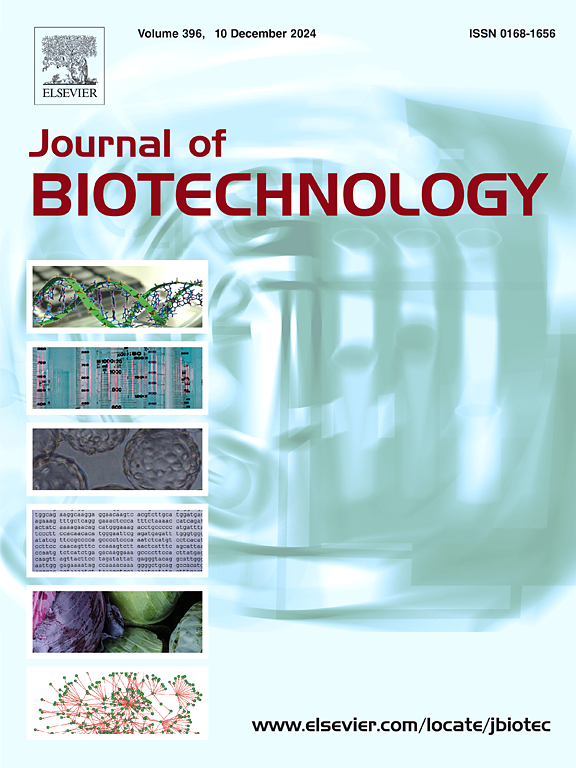基于代谢工程的地衣芽孢杆菌MW03高产2,3-丁二醇和乙酰素协同策略
IF 3.9
2区 生物学
Q2 BIOTECHNOLOGY & APPLIED MICROBIOLOGY
引用次数: 0
摘要
地衣芽孢杆菌对葡萄糖的快速利用和对工业发酵条件的适应性使其成为生产2,3-丁二醇(2,3- bd)和乙素的有效平台。本研究分离到了产乙酰托因和2,3- bd高产的地衣芽孢杆菌MW03,这两株菌株分别携带acoR和budC基因突变,分别编码乙酰托因脱氢酶调控因子和中位-2,3- bd脱氢酶。为了进一步确认对乙酰托因和2,3 BD生物合成的生理影响,利用CRISPR-Cas9系统进行基因编辑,然后进行表型筛选和基因型验证。敲除acoR和budC使乙酰素最大效价分别提高21.2%和49.2%。敲除budC后,D-(-)-2,3- bd的光学纯度达到92.7%。与原生acoR相比,异源表达地衣芽孢杆菌2709 acoR野生型和acoR敲除突变体均能显著抑制乙酰素积累,这强调了acoR在乙酰素积累中的调节作用。相反,budC的互补恢复了中位-2,3- bd合成的合成,强调了它在该过程中的重要性。acoR突变体中过表达alsD使2,3- bd滴度提高61.9%,达到121.97g/L,而产量达到2.03g/L·h。最后,bdhA和gldA的共表达使2,3- bd产量增加25.6%。本研究阐明了acoR和budC对乙酰托因和2,3- bd代谢的双重调控作用,建立了“敲除-过表达”协同策略,为进一步菌株优化提供了理论支持和实践指导。本文章由计算机程序翻译,如有差异,请以英文原文为准。
Synergistic strategy for high-yield 2,3-butanediol and acetoin production in Bacillus licheniformis MW03 based on metabolic engineering
Bacillus licheniformis is an efficient platform for 2,3-butanediol (2,3-BD) and acetoin production due to its rapid glucose utilization rate and adaptability to industrial fermentation conditions. Here, we isolated the B. licheniformis strain MW03 with high yield of acetoin and 2,3-BD, which carried genetic mutations in acoR and budC, respectively encoding an acetoin dehydrogenase regulator and meso-2,3-BD dehydrogenase. To further confirm the physiological effects on acetoin and 2,3 BD biosynthesis, gene editing was performed using the CRISPR-Cas9 system, followed by phenotypic screening and genotype validation. The knockout of acoR and budC increased the acetoin maximum titer by 21.2 % and 49.2 %, respectively. Moreover, the optical purity of D-(-)-2,3-BD reached 92.7 % following the knockout of budC. Heterologous expression of acoR from B. licheniformis 2709 in both the wild type and acoR knockout mutant strongly inhibited acetoin accumulation compared to native acoR, which emphasized the regulatory role of AcoR in acetoin accumulation. Conversely, complementation of budC restored the synthesis of meso-2,3-BD synthesis, emphasizing its importance in this process. Overexpression of alsD in the acoR mutant increased the 2,3-BD titer by 61.9 % to 121.97 g/L, while the productivity reached 2.03 g/L·h. Finally, co-expression of bdhA and gldA increased 2,3-BD production by 25.6 %. This study elucidated the dual regulatory roles of acoR and budC in acetoin and 2,3-BD metabolism, establishing a "knockout-overexpression" synergic strategy, which offers theoretical support and practical guidance for further strain optimization.
求助全文
通过发布文献求助,成功后即可免费获取论文全文。
去求助
来源期刊

Journal of biotechnology
工程技术-生物工程与应用微生物
CiteScore
8.90
自引率
2.40%
发文量
190
审稿时长
45 days
期刊介绍:
The Journal of Biotechnology has an open access mirror journal, the Journal of Biotechnology: X, sharing the same aims and scope, editorial team, submission system and rigorous peer review.
The Journal provides a medium for the rapid publication of both full-length articles and short communications on novel and innovative aspects of biotechnology. The Journal will accept papers ranging from genetic or molecular biological positions to those covering biochemical, chemical or bioprocess engineering aspects as well as computer application of new software concepts, provided that in each case the material is directly relevant to biotechnological systems. Papers presenting information of a multidisciplinary nature that would not be suitable for publication in a journal devoted to a single discipline, are particularly welcome.
 求助内容:
求助内容: 应助结果提醒方式:
应助结果提醒方式:


